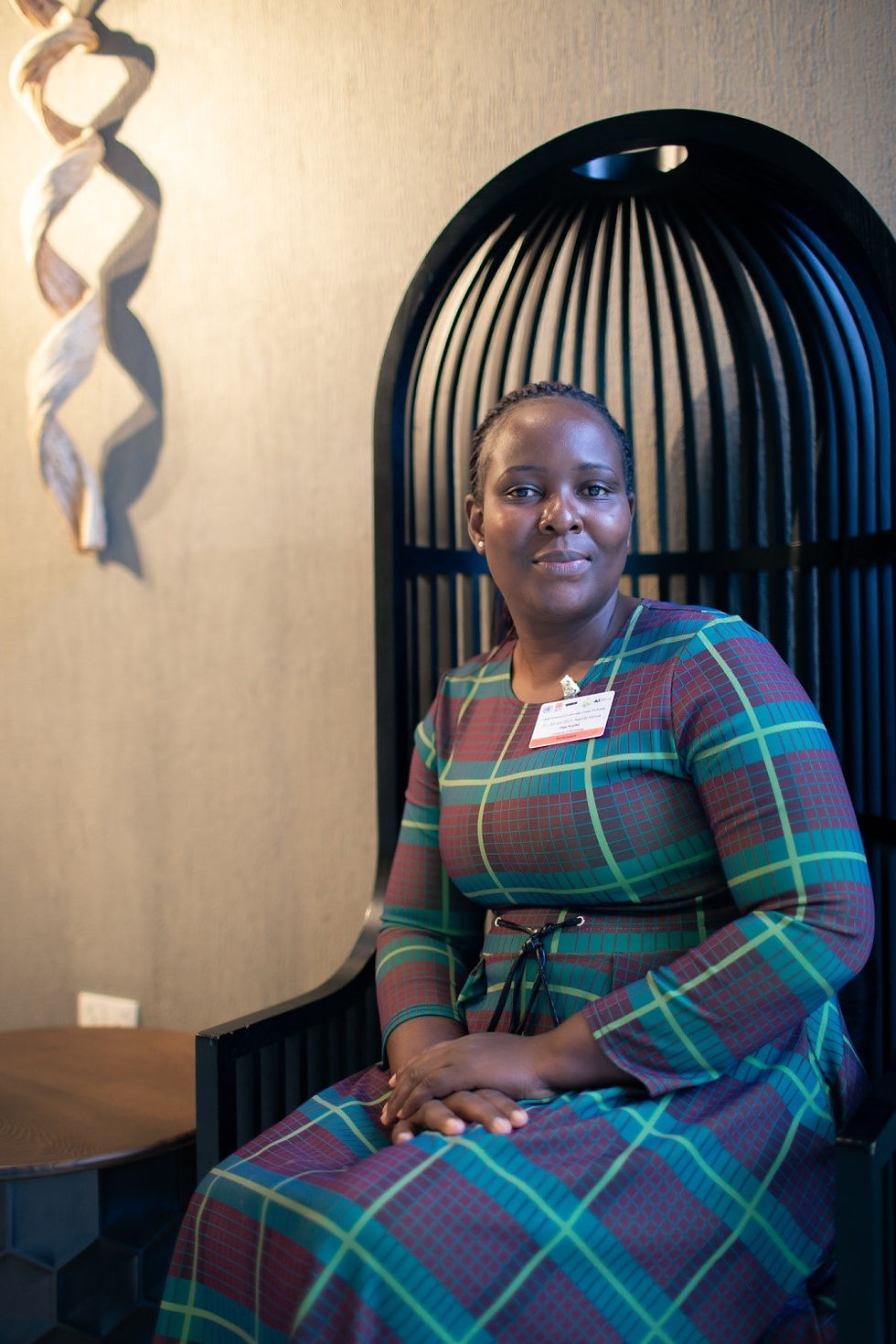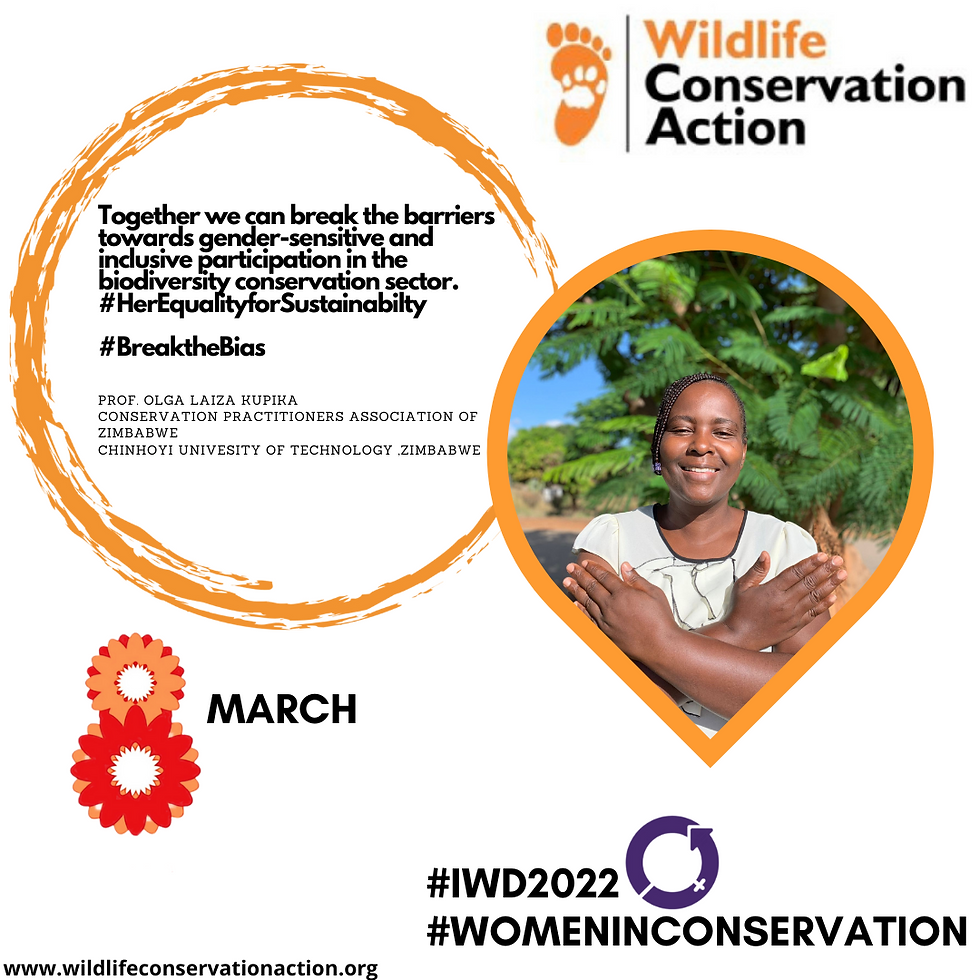Women in Conservation: The story of Professor Olga Laiza Kupika
- moreangelsm
- Mar 15, 2022
- 5 min read
Updated: Mar 15, 2022

In this article
Who is Professor O.L Kupika
Designation
Some of her duties
Who inspired her to pursue a carrier in conservation
What motivates her to do her job
Challenges being faced by women in conservation field
Suggested Solutions to the challenges being faced by women in conservation
Most exciting or memorable experiences in her job
Most challenging experiences in her job
Why is it Important to protect and conserve wildlife
Favorite Animal

Who is Professor Olga Laiza Kupika
Professor Olga Laiza Kupika is a Natural Resources Conservationist and Climate Change adaptation expert, Associate Professor and currently Chairperson for the Department of Wildlife Ecology and Conservation in the School of Wildlife and Environmental Sciences at Chinhoyi University of Technology, Zimbabwe. Professor O.L Kupika is a task oriented, result focused individual with over a decade of experience in research, teaching and community service in the higher and tertiary education sector. She has experience in leading and working with multidisciplinary teams and have ability to communicate with stakeholders and research partners at local, national, regional and international forums. Her research interests include climate change adaptation, ethnobiology, biodiversity conservation, ecosystem services, sustainable livelihoods, rural community resilience and education for sustainable development.
https://www.linkedin.com/in/olga-laiza-kupika-7396a3136/; https://twitter.com/olkupika; https://www.researchgate.net/profile/Olga_Kupika
Designation

Associate Professor in Natural Resources Conservation and climate change
Chairperson for the Department of Wildlife Ecology and Conservation in the School of Wildlife and Environmental Sciences at Chinhoyi University of Technology, Zimbabwe
Some of her duties
Administrative duties; Research proposal development for funding; Teaching and Supervising postgraduate and undergraduate students; Community Outreach and Income Generation in line with 5.0 Education strategy (Research and Resource Mobilization, Teaching, Innovation, Industrialization and Technological Development); Providing academic mentorship and guidance to early career researchers; Non-paid Consultancy.
Who inspired her to pursue a carrier in conservation
Question : Who inspired you to pursue a carrier in conservation?
Answer : Growing up I had a strong passion for nature mainly because I grew up close to a protected area (my rural home community is located at the periphery of the Gonarezhou Transfrontier Conservation Area). My childhood experiences within my indigenous Shangani community as they interacted with wildlife motivated me to pursue a career in the conservation sector.

What motivates her to do her job
Question: What motivates you to do your job ?
Answer : The love for mother nature and humanity and the desire to contribute towards sustainable wildlife conservation initiatives among the vulnerable indigenous peoples, women and young people. Also , the desire to empower women through training, capacity building, awareness raising and advocacy on biodiversity conservation #GenderIsABiodiversityIssue

Challenges being faced by women in conservation field
Question : What are the major challenges being faced by women in the conservation field?
Answer : Women in conservation particularly those in the education side face several challenges some of which are deeply rooted in socio-cultural beliefs and practices. Women also generally face challenges when it comes to work-life balance due their additional socio-cultural roles and responsibilities. Women face challenges with regards to accessing competitive research funding opportunities for professional and career growth. This may be due to late enrolment for higher education as they attend other family tasks associated with child bearing. Gender stereotyping is also common in the conservation sector.
Suggested Solutions to the challenges being faced by women in conservation
Question: Given the challenges that you have mentioned above, what can be done to provide more support for women working in conservation?
Answer : Institutions of higher education should continue to promote and embrace gender based initiatives towards achieving gender equality and equity. Overcoming such barriers requires an inclusive and supportive learning and working environment. Establishing a quota for women and widening the entry requirements for enrolling into higher education and accessing conservation research funding opportunities helps to close the gap and overcome barriers for career progression and eventual professional development.

Advice to other females who would want to pursue conservation career.
Question: What advice can you give to other females who would want to pursue conservation career ?
Answer :
The field of wildlife ecology and conservation sector is diverse and offers vast opportunities owing to the paradigm shift in the approaches to conservation.
Career guidance coupled with extensive study to understand contemporary issues is vital so as to develop relevant novel research which helps solve biodiversity related challenges and add value to the conservation sector.
The conservation field is highly practical and quite progressive in terms of technical and professional skills and so requires early career researchers to reach out for available opportunities to keep on advancing their knowledge through enrolling for available professional and technical online and physical courses.
During undergraduate and postgraduate studies, young and aspiring young conservationists should identify their niche in the conservation sector as this enables one to focus and reach out for mentorship and coaching programmes to allow for professional growth. Where possible, reach out for voluntary positions with private and public conservation related organizations to gain practical experiences which can enrich your curriculum vitae in preparation for future career engagements.
Conservation finance is limited and available on a competitive basis. Dare to make a practical difference and establish yourself under the guidance and supervision of established research champions and leaders. This will enable you to access the much needed support to motivate for the funding opportunities.
Networking and collaboration at institutional, national, regional and international level is key to realizing vast opportunities and reaching out to conservation finance opportunities in the conservation sector. However, this can happen progressively as one pursues their conservation interests.
6. Be humble, keep focused and committed; take each day as a learning curve.
Most exciting or memorable experiences in your job
Question: What are the most exciting or memorable experiences in your job?
Answer: Community outreach programs, field excursions and carrying out participatory research with indigenous peoples living on the edge of protected areas especially the Shangani (to which I belong) close to Gonarezhou National Park; the vaTonga in Binga (living close to Chizarira National Park) and the Korekore in Mbire (living close to Mana Pools National Park).

Olga Laiza Kupika (second from left) with participants during a tour along the Angwa River in Mbire District, Zimbabwe.
Photo Credits: (Olga, CR4D Project)

Olga Laiza Kupika (second from right) with FGD participants in Chiredzi District, Zimbabwe.
Photo Credits: (Eugene Ncube, Chinhoyi University of Technology, CR4D Project)
Most challenging experiences in her job
Question: What are the most challenging experiences in your Job?
Answer: Learning to multi-task and maintaining a healthy work life balance
Why is it Important to protect and conserve wildlife

Wildlife is part of our heritage; it provides tangible and intangible benefits to society. Wildlife should be protected for the sake of future generations; they still need to enjoy the vast wildlife resources at the same time benefiting from them. Sustainable wildlife conservation initiatives are key to achieving conservation related sustainable development goals. Healthy ecosystems are sustained by diverse wildlife resources which also provide variety of goods and services for the benefit of humanity; hence the wildlife economy enterprises which generate revenue and contribute to the national development. Wildlife should also be conserved because of its aesthetic value; it has the right to exist.
Favorite Animal

Question: What is your favorite animal and why?
Answer : My favorite animal is the samango monkey; that’s my totem; besides, it’s considered as a clever animal in our culture.




Comments